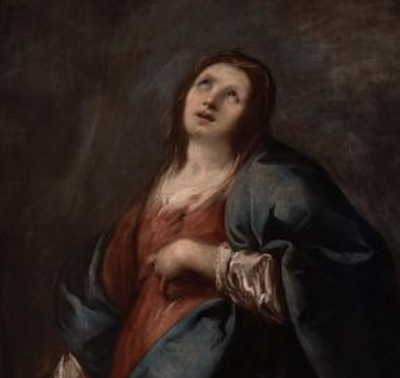Italian school, follower of GIACINTO BRANDI (Poli, Italy, 1621- Rome, 1691), around 1700. "Jesus in the Garden of Gethsemane." Oil on canvas.
Lot 30
About Seller
Setdart Auction House
Carrer Aragó 346
Barcelona
Spain
Setdart Subastas was born in 2004 and is currently the first online art auction in Spain with solidity, prestige and reliability guaranteed by our more than 60,000 users. Setdart has a young, dynamic and enterprising team ready to successfully manage the purchase and sale of art works through custom...Read more
Estimate:
EUR€1,500 - EUR€2,000
$1,612.90 - $2,150.54
Absentee vs Live bid
Two ways to bid:
- Leave a max absentee bid and the platform will bid on your behalf up to your maximum bid during the live auction.
- Bid live during the auction and your bids will be submitted real-time to the auctioneer.
Bid Increments
| Price | Bid Increment |
|---|---|
| EUR€0 | EUR€10 |
| EUR€200 | EUR€25 |
| EUR€500 | EUR€50 |
| EUR€1,000 | EUR€100 |
| EUR€3,000 | EUR€200 |
| EUR€5,000 | EUR€500 |
| EUR€10,000 | EUR€1,000 |
| EUR€20,000 | EUR€2,000 |
| EUR€50,000 | EUR€5,000 |
About Auction
By Setdart Auction House
May 31, 2021
Set Reminder
2021-05-31 08:30:00
2021-05-31 08:30:00
America/New_York
Bidsquare
Bidsquare : OLD MASTERS - Day 1
https://www.bidsquare.com/auctions/setdart-auction-house/old-masters---day-1-6998
Setdart Auction House sofia@setdart.com
Setdart Auction House sofia@setdart.com
- Lot Description
Italian school, follower of GIACINTO BRANDI (Poli, Italy, 1621- Rome, 1691), around 1700. "Jesus in the Garden of Gethsemane." Oil on canvas. It has an old label on the back, partially illegible indicating origin (Amsterdam). Features a refreshed golden vintage frame. Measures: 44 x 35 cm; 54 x 45 cm (frame). The scene offers us an intimate and original vision of Christ's Prayer in the Garden of Olives. The night before the Crucifixion Christ withdraws, with some of his apostles, to the outskirts of Jerusalem, to what is known as the Garden of Olives, where the next morning he will be denounced by Judas and seized by the Roman troops. Christ turns to his Father, imploring his mercy, but he also shows himself ready to drink the cup of suffering that God has prepared for him. This devotional painting depicts Jesus in Gethsemane, the garden where, according to the New Testament, Jesus prayed the last night before being arrested. It is the moment when the angel comforts him (Matthew: ch. 26 v. 37; Mark: ch. 14 v. 33). The Gospels narrate that, distressed by a strange sadness, Jesus went to pray on the Mount of Olives, where the apostles followed him. Once there, Jesus withdraws to one side to pray, the moment of the crucifixion becoming present to him. Thus, this episode begins the bloody Passion in the soul of Christ. The apostles fall into a deep sleep, and an angel appears to Jesus to comfort him. In fact, this episode alludes to the greatest temptation of Jesus' life, the last of all: knowing his destiny, he can either flee from his enemies or continue to fulfill his divine mission, risking his life. The composition focuses, on the other hand, on the figure of Jesus, defeated, and without any element except the angels, which could distract the viewer from the image of Christ. Due to its technical and thematic characteristics, the author presents us with a scene with a clear aesthetic influence based on Giacinto Brandi's painting "Jesus in the Garden", which today is in the collection of the Vatican Pinacoteca. Born in Rome, Giacinto Brandi was part of the studio of Alessandro Algardi, a prominent sculptor who noticed that Brandi was better suited to painting. He later joined the studio of Giovanni Giacomo Sementi. He traveled to Naples from 1638, and by 1647 had returned to Rome to work with Giovanni Lanfranco, where Brandi befriended Mattia Preti. His works are distributed among the Baroque churches of Rome, including the ceiling frescoes of San Carlo al Corso (1670-1671), San Silvestro in Capite, Sant'Andrea al Quirinale, a canvas of Sant'Andrea (1650) in Santa Maria in Via Lata, a painting of the Martyrdom of the Forty (1660) for the Chiesa delle Santissima Stimmate di San Francesco, a Coronation of the Virgin (1680) serving as the main altarpiece for the church of Gesù e Maria, a canvas of the Drunkenness of Noah in the Galleria Corsini, an Assumption (1655) for Santa Maria in Organo in Verona, a fresco of Ovid's Metamorphoses (1651-1653) for the Palazzo Pamphilj in Piazza Navona and a Martyrdom of San Biagio for the church of San Carlo ai Catinari; a Visione del beato Giovanni di San Facondo (1656) and an Estai della beata Rita da Cascia (1660) in the Basilica di Sant'Agostino in Campo Marzio, San Rocco intercede per i malati di peste (1673) and San Rocco in gloria (1674) in the Chiesa di San Rocco all'Augusteo; Compianto sul Cristo morto (1675-76) in the Chiesa di Sant'Andrea al Quirinale. In 1651 he was admitted to the Accademia di San Luca for painters.
- Shipping Info
-
In-house shipping available. Please inquire at admin@setdart.com.
-
- Buyer's Premium



 EUR
EUR CAD
CAD AUD
AUD GBP
GBP MXN
MXN HKD
HKD CNY
CNY MYR
MYR SEK
SEK SGD
SGD CHF
CHF THB
THB
















